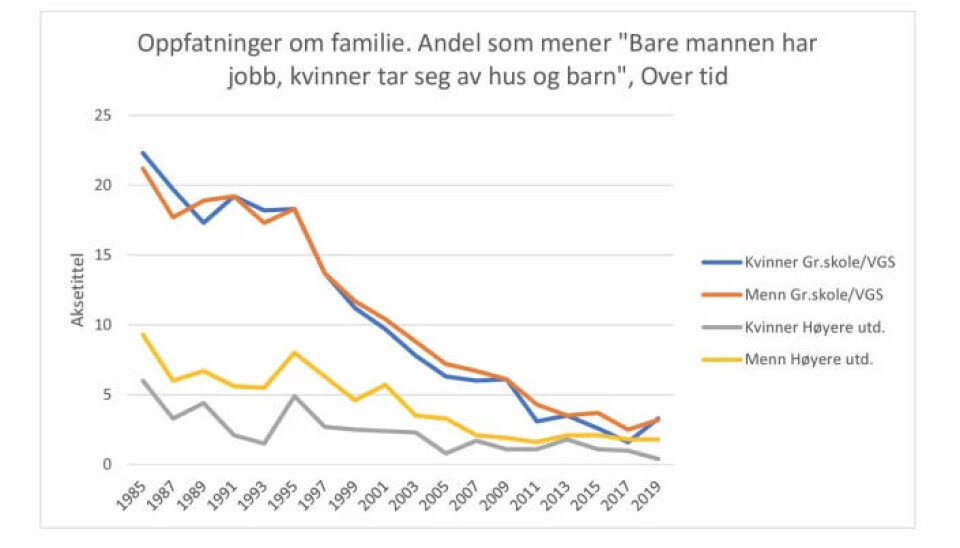
Working-class men disagree the most with well-educated women
They represent opposite points of view in many questions about equality, a new Norwegian report shows.
Social scientist Jørn Ljunggren is a little surprised at how systematic these differences are. He works as a researcher at OsloMet’s Norwegian Social Research institute (NOVA).
“We can safely say that less-educated men stand out in these questions.”
And so do women with more education, he points out.
Ljunggren has recently written a report for the Norwegian Gender Equality and Anti-Discrimination Ombud (LDO).
Senior adviser Knut Oftung in LDO explains why they wanted this report:
“The general opinion is that men with less education are opposed to and work against equality. This is an interesting debate that is going on internationally. We were interested in getting input to this question in Norway.”

No hard and fast answer
The report looks at differences in attitudes to equality and what is done in practice in Norwegian homes.
It poses the question: Are working-class men the obstacle to equality?
To find answers, Ljunggren used interview data from Norsk Monitor, a large survey of Norwegian values, attitudes and behaviour. A representative sample of the Norwegian population over the age of 15 have been asked questions about equality every two years since 1985.
The researcher will not answer yes or no to the question he poses in the report.
He believes the data go in too many directions to do that.
More traditional attitudes
“However, many responses tend toward a ‘yes’ answer,” Ljunggren says.
For example, significantly more men with less education believe that ‘women and men are very different from the perspective of nature.’
By ‘less education,’ the researchers refer to individuals who have no education beyond primary or upper secondary school.
Less-educated men also more often believe that women do not have the same need for a professional career than men do.
They believe that a family should be organized so that the woman has a less demanding job and bears the main responsibility for the home.
Several men in this group also believe that men and women should not share the responsibility for housework and child-rearing equally. They also most often answer that their partner does most of the work at home.
When they then, in addition to all of the above, also more frequently respond that no discrimination between the sexes exists in society - it is not unreasonable to conclude that this group of men is slowing down progress toward equality.
A lot has happened
Ljunggren nevertheless does not want to say that working-class men are an obstacle to gender equality, for several reasons.
“Men with less education have slightly more traditional attitudes and slightly different gender equality practices. But progress has still been enormous over the past 30-40 years.”
About 40 years ago, more than one in five men with less education said they preferred a family where the man has a job and the woman takes care of the children.
In 2019, only 3 out of 100 less-educated men gave the same answer.

Small differences
The vast majority of men who are asked today say that they prefer gender equality.
And more than nine out of ten men believe that women have the same need for a professional career as men.
“The development trends from 1985 are quite striking. A lot has shifted in the attitudes to equality since then. And men with less education are also on board with that wave,” says Ljunggren.
Although men with less education still stand out in the vast majority of areas, the differences are quite small today.
“The majority of men with less education agree with the direction we’re taking on the gender equality project. So it’s important not to exaggerate how different they are,” the researcher believes.
Not a small or unimportant group
Ljunggren thinks men with less education are an interesting group to look at when it comes to equality issues.
“We often talk about this group from a perspective of what's problematic," Ljunggren says, pointing out that less educated men actually make up around 70 per cent of all Norwegian men.
Given that there are so many of them, what these men think is hardly irrelevant.
And yet, Ljunggren believes, one can get the impression that they’re a small and unimportant group in today's Norway.
Rarely researched
Despite the fact that the group is so large, it is rarely researched, even though Norway conducts a lot of research on gender equality issues.
Nor is the public conversation dominated by men – or women – with limited education, says the researcher.
“We rarely read debates about gender equality where someone advocates for the opinions that people with less education show that they have in this survey.”
Work limits equality
Christian Justnes in the Norwegian Federation of Trade Unions believes that employer attitudes have a great impact on how gender equal things are in people's homes.
Figures from Statistics Norway show that more highly educated men, for example, use the paternity leave quota to a much greater extent than men with less education.
“The fact that craftsmen don't take advantage of the paternity leave is, I think, often a matter of the employer not wanting it. It could also be because of money. Men often earn more than women in the working class,” Justnes said.

Paternity leave – not workable for the working-class?
Knut Oftung in LDO is also concerned that the use of paternity leave – or the “father’s quota,” the crown jewel of Norwegian gender equality – varies greatly among men.
Forty percent of Norwegian fathers do not make full use of this provision. And Oftung believes this fact has a class perspective.
“The father’s quota doesn’t actually work very well for working-class men,” he says.
Equality and discrimination ombudsman, Bjørn Erik Thon, believes we need to ask ourselves why this is the case.
These are questions that he hopes the newly established Mannsutvalg (Men's Committee) – created to look at the equality challenges men face – will address.
Ljunggren also hopes that the Men's Committee will look at how men's and women's work life obstructs progress towards equality.
“If you start work at 07.00 in the morning, like working-class men often do, who’s going to bring the children to kindergarden?” he asks.
Reference:
Jørn Ljunggren: Likestillingens bremsekloss? (Obstacles to equality? – in Norwegian). A report on differences in gender equality attitudes and actions between women and men with varying education levels. Report. Gender Equality and Anti-Discrimination Ombud (LDO), 2022.
———
Read the Norwegian version of this article at forskning.no
------

































